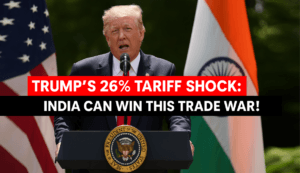Trump’s 26% Tariff Shock: How India Can Win This Trade War!
Donald Trump has announced new reciprocal tariffs, imposing a 26% levy on Indian exports to the US. This move aims to counter what he calls “unfair trade practices,” as India reportedly charges a 52% tariff on US goods. While the tariff hike poses challenges, India fares better than competitors like China (34%) and Vietnam (46%), potentially maintaining an edge in key sectors like textiles, pharmaceuticals, and electronics. The US remains India’s top trading partner, with bilateral trade accounting for over 18% of India’s exports and a $35.32 billion trade surplus in 2023-24.
The tariffs, effective from April 9, will impact multiple industries, but some, like steel and semiconductors, remain exempt. India now faces a strategic choice—either negotiate better trade terms or risk further economic strain. The ongoing trade discussions between New Delhi and Washington offer hope for potential tariff reductions. Ultimately, India must adapt by improving competitiveness, exploring new markets, and leveraging diplomatic channels to secure favorable terms.

Trump’s 26% Tariff Shock: How India Can Win This Trade War!
Former U.S. President Donald Trump recently announced new tariffs targeting several countries, including India, in an effort to address what he calls “unfair trade imbalances.” Under his “reciprocal tariffs” policy, the U.S. will adjust import duties to match those imposed by other nations on American goods. Here’s a breakdown of how this affects India and its broader implications:
Why the Tariffs?
Trump argued that many countries, including India, impose significantly higher tariffs on U.S. exports than the U.S. does on their goods. For instance:
- Cars: India imposes a 70% tariff on U.S. vehicles, while the U.S. charges only 2.5% on Indian cars.
- Electronics: India applies a 10% tariff on network equipment, whereas the U.S. levies zero duties on similar Indian imports.
- Agriculture: U.S. husked rice faces a 50% tariff in India, while India’s rice exports to the U.S. are taxed at just 2.7%.
To balance the trade equation, Trump introduced a 26% tariff on Indian goods, effective April 2025.
Sectors Impacted in India
The increased tariffs will raise costs for many Indian exports to the U.S., including:
- Agriculture: Meat, seafood, cereals, fruits, and edible oils.
- Pharmaceuticals: Generic medicines and specialty drugs.
- Jewelry: Diamonds, gold, and silver.
- Electronics and Textiles: Telecom equipment, fabrics, and carpets.
- Auto Parts: Tires and belts.
Exemptions
A few sectors, such as steel, aluminum, automobiles, copper, and semiconductors, remain unaffected due to existing tariffs or strategic exemptions.
Unexpected Advantages for India
Despite concerns over the tariff hike, India may still benefit in three key ways:
- Competitive Edge: India’s 26% tariff is lower than what its competitors face—China (34%), Vietnam (46%), and Bangladesh (37%). This could give Indian exporters an advantage in sectors like textiles and electronics.
- Negotiation Opportunities: The U.S. has signaled flexibility, offering to revise tariffs if India lowers its trade barriers. Bilateral talks are ongoing, and a reduction or exemption could be secured by late 2025.
- Avoiding Escalation: Unlike China and other nations facing steeper tariffs, India has less incentive to retaliate. Instead, it can focus on trade reforms and partnerships rather than risking a trade war.
Global Tariff Landscape
Trump’s two-tier tariff system includes a 10% base rate for all imports, plus additional country-specific duties:
- Highest Tariffs: Cambodia (49%), Vietnam (46%), Bangladesh (37%).
- Lowest Tariffs: Close allies like the U.K., Australia, and Brazil, which face only 10%.
India-U.S. Trade Dynamics
The U.S. is India’s largest trade partner, accounting for 18% of its exports. Key details:
- India’s Exports to the U.S.: Pharmaceuticals ($8.1B), telecom equipment ($6.5B), jewelry ($8.5B), and petroleum products ($4.1B).
- U.S. Exports to India: Crude oil ($4.5B), coal ($3.4B), and diamonds ($2.6B).
- Trade Surplus: India exports $35.3B more to the U.S. than it imports.
What’s Next?
India faces a critical choice: accept the tariffs or negotiate concessions. While retaliation could strain economic ties, constructive negotiations may lead to exemptions or reduced rates. In the meantime, Indian exporters in vulnerable sectors must adapt, while the government explores long-term strategies to strengthen global trade partnerships.
Final Takeaway
While Trump’s tariffs pose challenges, they also push India to rethink protectionist policies and pursue fairer trade agreements. By leveraging its competitive position and diplomatic channels, India can turn this hurdle into an opportunity—fostering economic growth and securing stronger international trade relationships.
You must be logged in to post a comment.